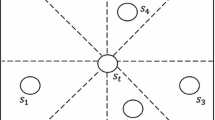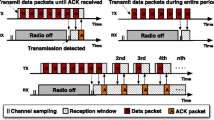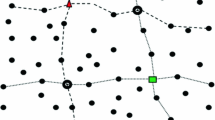Abstract
In this paper, we present a new “spatiotemporal multicast”, called a “mobicast”, protocol for supporting applications which require spatiotemporal coordination in sensornets. The spatiotemporal character of a mobicast is to forward a mobicast message to all sensor nodes that will be present at time t in some geographic zone (called the forwarding zone) Z, where both the location and shape of the forwarding zone are a function of time over some interval (t start ,t end ). The mobicast is constructed of a series of forwarding zones over different intervals (t start ,t end ), and only sensor nodes located in the forwarding zone in the time interval (t start ,t end ) should be awake in order to save power and extend the network lifetime. Existing protocols for a spatiotemporal variant of a multicast system were designed to support a forwarding zone that moves at a constant velocity, \(\overrightarrow{v}\), in sensornets. To consider the path of a mobile entity which includes turns, this work mainly develops a new mobicast routing protocol, called the variant-egg-based mobicast (VE-mobicast) routing protocol, by utilizing the adaptive variant-egg shape of the forwarding zone to achieve high predictive accuracy. To illustrate the performance achievement, a mathematical analysis is conducted and simulation results are examined.
Similar content being viewed by others
References
I.F. Akyildiz, W. Su, Y. Sankarasubramaniam and E. Cayirci, A survey on sensor networks, IEEE Communications Magazine 40 (August 2002) 102–114.
P. Bauer, M. Sichitiu, R. Istepanian and K. Premaratne, The mobile patient: wireless distributed sensor networks for patient monitoring and care, in: Proceedings of the IEEE Conference on Information Technology Applications in Biomedicine (ITAB) (November 2000) pp. 17–21.
J. Boleng, T. Camp and V. Tolety, Mesh-based geocast routing protocols in an Ad Hoc network, in: Proceedings of the IEEE International Parallel and Distributed Processing Symposium on Wireless Networks and Mobile Computing (IPDPS) (April 2001) pp. 184–193.
P. Bose and P. Morin, An imporved algorithm for subdivision traversal without extra storage, International Journal of Foundations of Computer Science (2002) 297–308.
P. Bose, P. Morin, I. Stojmenovic and J. Urrutia, Routing with guaranteed delivery in Ad Hoc wireless networks, ACM Wireless Networks 3(4) (2001) 609–616.
A. Cerpa, J. Elson, D. Estrin, L. Girod, M. Hamilton and J. Zhao, Habitat monitoring: application driver for wireless communications technology, in: Proceedings of IEEE Special Interest Group on Data Communication (SIGCOMM) (April 2001) pp. 20–41.
B. Chen, K. Jamieson, H. Balakrishnan and R. Morris, Span: An energy-efficient coordination algorithm for topology maintenance in Ad Hoc wireless networks, in: Proceedings of ACM International Conference on Mobile Computing and Networking (MobiCom) (July 2001) pp. 85–96.
Q. Fang, F. Zhao and L. Guibas, Lightweight sensing and communication protocols for target enumeration and aggregation, in: Proceedings of the ACM International Symposium on Mobile Ad Hoc Networking and Computing (MobiHoc) (June 2003) pp. 165–176.
J.L. Gao, An adaptive network/routing algorithm for energy efficient cooperative signal processing in sensor networks, in: Proceedings of the IEEE Aerospace Conference 3 (March 2002) pp. 1117–1124.
Q. Huang, C. Lu and G.-C. Roman, Spatiotemporal multicast in sensor networks, in: Proceedings of the ACM Conference on Embedded Networked Sensor Systems (SenSys) (November 2003) pp. 205–217.
Q. Huang, C. Lu and G.-C. Roman, Design and analysis of spatiotemporal multicast protocols for wireless sensor networks, Telecommunication Systems, Special Issue on Wireless Sensor Networks 26(2-4) (August 2004) 129–160.
Q. Huang, C. Lu and G.-C. Roman, Reliable mobicast via face-aware routing, in: Proceedings of the IEEE International Conference on Computer Communications (INFOCOM) (March 2004).
C. Intanagonwiwat, R. Govindan, D. Estrin, J. Heidemann and F. Silva, Directed Diffusion for Wireless Sensor Networking. IEEE/ACM Transactions on Networking 11(1) (February 2003) 2–16.
Y. Ko and N. Vaidya, Geocasting in Mobile Ad Hoc networks: Location based multicast algorithms, in: Proceedings of the IEEE Workshop on Mobile Computing Systems and Applications (WMCSA) (February 1999) pp. 101–110.
Y.-B. Ko and N. H. Vaidya, GeoTORA: A protocol for geocasting in mobile Ad Hoc networks. in: Proceedings of the IEEE International Conference on Network Protocols (ICNP) (November 2000) pp. 14–17.
M. Kochhal, L. Schwiebert and S. Gupta, Role-based hierarchical self organization for wireless Ad Hoc sensor networks, in: Proceedings of the ACM international Conference on Wireless Sensor Networks and Applications (WSNA) (September 2003) pp. 98–107.
G. Kulkarni, C. Schurgers and M. Srivastava, Dynamic link labels for energy-efficient MAC headers in wireless sensor networks, in: Proceedings of IEEE Sensors Vol. 2 (June 2002) pp. 1520–1525.
W.-H. Liao, Y.-C. Tseng, K.-L. Lo and J.-P. Sheu, Geogrid: A geocasting protocol for mobile Ad Hoc networks based on grid, Journal of Internet Technology 1(2) (December 2000) 23–32.
J. Liu, J. Reich and F. Zhao, Collaborative in-network processing for target tracking, EURASIP Journal on Applied Signal Processnig 4 (2003) 378–391.
M. Maleki and M. Pedram, Lifetime-aware multicast routing in wireless Ad Hoc networks, in: Proceedings of the IEEE Wireless Communications and Networking Conference (WCNC) Vol. 3 (March 2004) pp. 1317–1323.
M. Mauve, A. Widmer and H. Hartenstein, A survey on position-based routing in mobile Ad Hoc networks, IEEE Network Magazine 1 (November 2001) 30–39.
S. Mishra and A. Nasipuri, An adaptive low-power reservation-based MAC protocol for wireless sensor networks, in: Proceedings of the International Performance, Computing, and Communications Conference (IPCCC) (April 2004) pp. 15–17.
J.C. Navas and T. Imielinski, Geocast-geographic addressing and routing, in: Proceedings of ACM International Conference on Mobile Computing and Networking (MobiCom) (September 1997) pp. 66–76.
G. Pei and C. Chien, Low power TDMA in large wireless sensor networks, in: Proceedings of the of Military Communications Conference (MILCOM) (October 2001) pp. 347–351.
K. Premaratne, J. Zhang and M. Dogruel, Location information-aided task-oriented self-organization of Ad-Hoc sensor systems, IEEE Sensors Journal 4(1) (February 2004) 85–95.
K. Sohrabi, J. Gao, V. Ailawadhi and G. J. Pottie, Protocols for self-organization of a wireless sensor network, IEEE Personal Communications 7(5) (October 2000) 16–27.
Y.-C. Tseng, S.-P. Kuo, H.-W. Lee and C.-F. Huang, Location tracking in a wireless sensor network by mobile agents and its data fusion strategies, The Computer Journal 47(4) (July 2004) 448–460.
S.-Y. Wang, NCTUns 2.0 network simulator and emulator, Network and System Laboratory, Department of Computer Science, National Chiao Tung University (NCTU), Taiwan, http://nsl10.csie.nctu.edu.tw/.
Eric W. Weisstein, Cassini ovals, From MathWorld. A Wolfram Web Resource. http://mathworld.wolfram.com/CassiniOvals.html.
H. Yang and B. Sikdar, A protocol for tracking mobile targets using sensor networks, in: Proceedings of the IEEE Workshop on Sensor Network Protocols and Applications (May 2003) pp. 71–81.
O. Younis and S. Fahmy, HEED: A hybrid, energy-efficient, distributed clustering approach for Ah Hoc sensor networks, IEEE Transaction on Mobile Computing 3(4) (October 2004) 366–379.
M.A. Youssef, M.F.Younis and K.A. Arisha, A constrained shortest-path energy-aware routing algorithm for wireless sensor networks, in: Proceedings of the IEEE Wireless Communications and Networking Conference (WCNC) 2 (March 2002) pp. 17–21.
Author information
Authors and Affiliations
Corresponding author
Additional information
Yuh-Shyan Chen received the M.S. and Ph.D. degrees in Computer Science and Information Engineering from the National Central University, Taiwan, Republic of China, in June 1991 and Jan. 1996, respectively. He joined the faculty of Department of CSIE, Chung-Hua University, Taiwan, in 1996. He joined the Department of Statistic, National Taipei University in Aug. 2000, and joined the Department of CSIE, National Chung Cheng University in Aug. 2002. Dr. Chen is an associate Professor from Aug. 2003. Since 2006, he has been a Professor at the Department of CSIE, National Taipei University, Taiwan. Dr. Chen served as Co-Editors-in-Chief of International Journal of Ad Hoc and Ubiquitous Computing (IJAHUC); Editorial Board Member of Telecommunication System; Guest Editor of Telecommunication Systems, special issue on “Wireless Sensor Networks” (2004). He was a Vice Co-Chair, Wireless IP Symposium of WirelressCOM, USA (2005); Workshop Co-Chair, IEEE AHUC06, Taiwan (2006); Program Co-Chairs, IFIP NCUS06, Korea (2006). Dr. Chen also served as Program Committee Member of ICPP’03, ICDCS’04, ICCCN’01–06, MSN’05, CCN’02–06, CSA’04 06, NCS’06, MSEAT’03–06, WASN06, USN06, MHNET06, PESYS06, ML06, IWWN06, UIC06, ICWMC06, and HWN-RMQ06; IASTED Technical Committee on Telecommunications (2002–2005); WSEAS International Scientific Committee Member (from 2004). His paper wins the 2001 IEEE 15th ICOIN-15 Best Paper Award. Dr. Chen was a recipient of the 2005 Young Scholar Research Award given by National Chung Cheng University to four young faculty members, 2005. His recent research topics include mobile ad-hoc network, wireless sensor network, and 4G system. Dr. Chen is a member of the IEEE Computer Society and Phi Tau Phi Society.
Shin-Yi Ann received the B.S. degree in computer science and engineering from the National Taiwan Ocean University, Taiwan, Republic of China, in June 2002 and the M.S. degree in computer science and information engineering from National Chung Cheng University, Taiwan, Republic of China, in July 2004. His research interest includes wireless sensor network.
Yun-Wei Lin received the B.S. degree in computer and information science from the Aletheia University, Taiwan, Republic of China, in June 2003 and the M.S. degree in computer science and information engineering from National Chung Cheng University, Taiwan, Republic of China, in July 2005. His research interests include mobile ad hoc network and wireless sensor network.
Rights and permissions
About this article
Cite this article
Chen, YS., Ann, SY. & Lin, YW. VE-mobicast: a variant-egg-based mobicast routing protocol for sensornets. Wireless Netw 14, 199–218 (2008). https://doi.org/10.1007/s11276-006-9957-9
Published:
Issue Date:
DOI: https://doi.org/10.1007/s11276-006-9957-9




